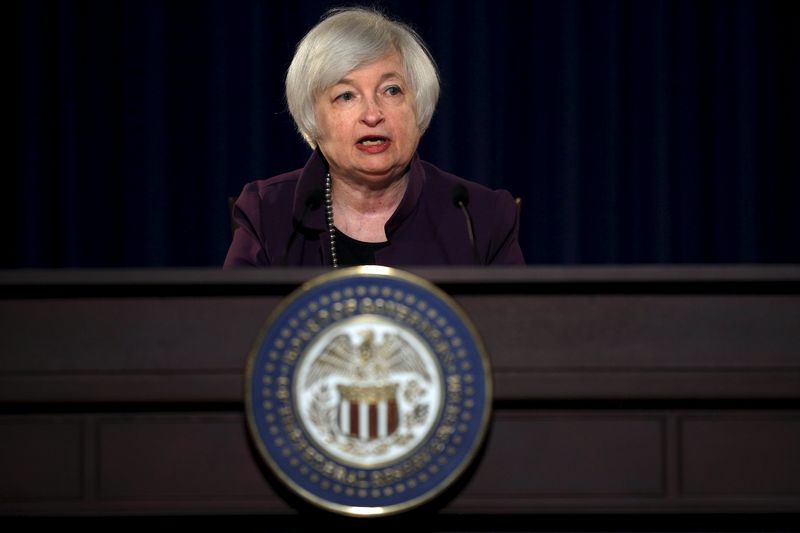(Bloomberg View) -- As the Federal Reserve prepares to hike interest rates at this week’s Open-Market Committee meeting, market participants are bidding up short-term rates -- moving toward the Fed expectations of more increases in 2018. That move could continue when the central bank reaffirms its commitment to further tightening next year.
Opposing forces challenge Fed policy makers as they chart a path for next year. Inflation disappointed in 2017, while unemployment forecasts proved too pessimistic. This combination puzzled the Fed, yet officials remained committed to their expectation of three 25 basis-point rate hikes. They sense a need to stay ahead of any potential overheating of the economy.
The Fed is likely to continue to point toward another 75 basis points of tightening in 2018 when it releases the next Summary of Economic Projections. To be sure, the minutes of the last FOMC meeting painted a dovish outlook as participants fretted about the inflation picture. But these concerns need to be weighed against the outlook for growth, which improved throughout 2017, and the implications of that accelerated growth on unemployment.
In September, the FOMC projected gross domestic product growth of 2.1 percent and a year-end unemployment rate of 4.1 percent for 2018. But unemployment already dipped to 4.1 percent in October of this year and held there in November while the economy maintains substantial momentum as the end of 2017 approaches. The New York and Atlanta Federal Reserve banks anticipate growth of 3.9 and 2.9 percent, respectively, in the fourth quarter. And the Fed chair nominee, Jerome Powell, said in his confirmation hearing that growth was on track to hit 2.5 percent next year, well above the current forecast.
It appears there is substantial room to raise the Fed’s 2018 growth forecast. Assuming the potential growth forecast holds at 1.8 percent, the stage is set for a sharp downward revision to the unemployment estimate. All else equal, this would push up the 2018 rate projection. But things become tricky because all else might not be equal.
In the context of this year’s inflation shortfall, central bankers might understandably revise downward their estimate of the longer-run unemployment rate. It seems unlikely, however, that the Fed would decrease it to the same magnitude as the downward revision of the 2018 unemployment forecast. Hence, the net impact of the unemployment changes should remain positive for the rate forecast.
Then there is the inflation estimate. Policy makers could bring down their 2018 forecasts. But they may be hesitant to do so. First, core-inflation numbers firmed in recent months, which will revive some hopes that the shortfall this year was indeed transitory. Second, they will be hesitant to lower the inflation projection if the unemployment gap forecast widens further. Third, they will be wary that inflation pressures are building but have not had time to emerge. And finally, they will be concerned about the potentially inflationary implications of the tax cut that is working its way through Congress.
Thus, the net impact of changes to the unemployment and inflation forecast should support at a minimum the Fed’s September forecast of three hikes for 2018. There remains another factor to consider, however -- the Fed’s estimate of the neutral short-term rate.
For now, central bankers believe the neutral rate is 2.8 percent. The stability of the long-end of the yield curve, however, suggests a lower rate. If Fed policy makers believe the same, they could hold the line on their inflation story while forecasting a larger gap between unemployment and its longer-run rate and still hold the policy rate forecast for 2018 constant.
One final complication: This analysis relies on predicting changes in the forecasts of underlying variables in the Fed’s reaction function to discern rate intentions. There is the possibility that in the context of solid growth numbers and easier financial conditions since the Fed started hiking rates, central bankers are already set on another 75 basis points of hikes for next year. They could then essentially reverse-engineer the economic forecasts to fit that scenario or simply fail to adjust the expected path of rates as expected to the changes in their forecasts. For example, I have written that the Fed’s the unemployment forecasts appear inconsistent with the growth forecasts. Moreover, inflation forecast revisions in 2017 arguably should have, but didn’t, trigger a reduction in the expected rate hikes for this year.
I anticipate the Fed will largely retain the policy rate forecast for 2018. This may come as a surprise given the dovish Fed minutes, but the recent surge in short-term rates indicates that financial markets are waking up to the reality that solid economic growth will prompt the bank to keep hiking rates despite low inflation. All else equal, the stage will be set for an inversion of the yield curve by the end of next year.
This column does not necessarily reflect the opinion of the editorial board or Bloomberg LP and its owners.
Tim Duy is a professor of practice and senior director of the Oregon Economic Forum at the University of Oregon and the author of Tim Duy's Fed Watch.
